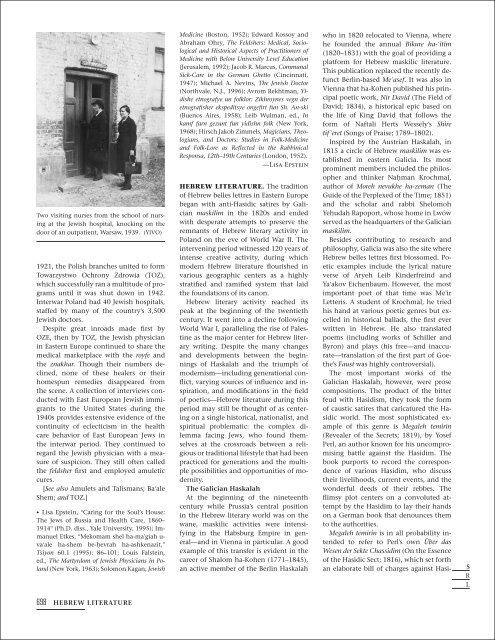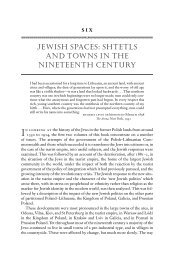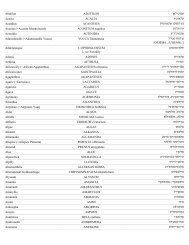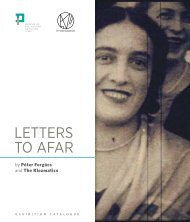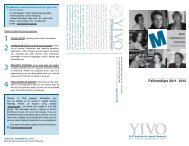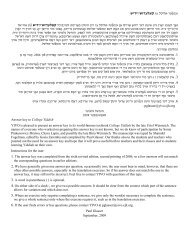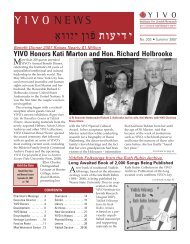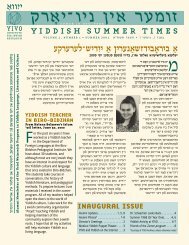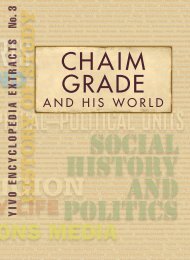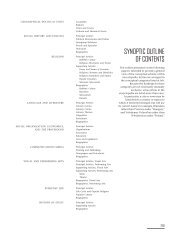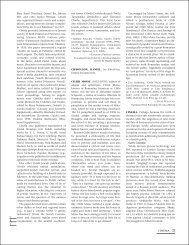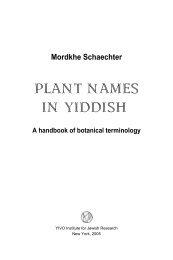Hebrew literature - YIVO Institute for Jewish Research
Hebrew literature - YIVO Institute for Jewish Research
Hebrew literature - YIVO Institute for Jewish Research
Create successful ePaper yourself
Turn your PDF publications into a flip-book with our unique Google optimized e-Paper software.
Two visiting nurses from the school of nursing<br />
at the <strong>Jewish</strong> hospital, knocking on the<br />
door of an outpatient, Warsaw, 1939. (<strong>YIVO</strong>)<br />
1921, the Polish branches united to <strong>for</strong>m<br />
Towarzystwo Ochrony Zdrowia (TOZ),<br />
which successfully ran a multitude of programs<br />
until it was shut down in 1942.<br />
Interwar Poland had 40 <strong>Jewish</strong> hospitals,<br />
staffed by many of the country’s 3,500<br />
<strong>Jewish</strong> doctors.<br />
Despite great inroads made first by<br />
OZE, then by TOZ, the <strong>Jewish</strong> physician<br />
in Eastern Europe continued to share the<br />
medical marketplace with the royfe and<br />
the znakhar. Though their numbers declined,<br />
none of these healers or their<br />
homespun remedies disappeared from<br />
the scene. A collection of interviews conducted<br />
with East European <strong>Jewish</strong> immigrants<br />
to the United States during the<br />
1940s provides extensive evidence of the<br />
continuity of eclecticism in the health<br />
care behavior of East European Jews in<br />
the interwar period. They continued to<br />
regard the <strong>Jewish</strong> physician with a measure<br />
of suspicion. They still often called<br />
the feldsher first and employed amuletic<br />
cures.<br />
[See also Amulets and Talismans; Ba‘ale<br />
Shem; and TOZ.]<br />
• Lisa Epstein, “Caring <strong>for</strong> the Soul’s House:<br />
The Jews of Russia and Health Care, 1860–<br />
1914” (Ph.D. diss., Yale University, 1995); Immanuel<br />
Etkes, “Mekomam shel ha-ma’giah uva‘ale<br />
ha-shem be-Õevrah ha-ashkenazit,”<br />
Tsiyon 60.1 (1995): 86–101; Louis Falstein,<br />
ed., The Martyrdom of <strong>Jewish</strong> Physicians in Poland<br />
(New York, 1963); Solomon Kagan, <strong>Jewish</strong><br />
698 HEBREW LITERATURE<br />
Medicine (Boston, 1952); Edward Kossoy and<br />
Abraham Ohry, The Feldshers: Medical, Sociological<br />
and Historical Aspects of Practitioners of<br />
Medicine with Below University Level Education<br />
(Jerusalem, 1992); Jacob R. Marcus, Communal<br />
Sick-Care in the German Ghetto (Cincinnati,<br />
1947); Michael A. Nevins, The <strong>Jewish</strong> Doctor<br />
(Northvale, N.J., 1996); Avrom Rekhtman, Yidishe<br />
etnografye un folklor: Zikhroynes vegn der<br />
etnografisher ekspeditsye ongefirt fun Sh. An-ski<br />
(Buenos Aires, 1958); Leib Wulman, ed., In<br />
kamf farn gezunt fun yidishn folk (New York,<br />
1968); Hirsch Jakob Zimmels, Magicians, Theologians,<br />
and Doctors: Studies in Folk-Medicine<br />
and Folk-Lore as Reflected in the Rabbinical<br />
Responsa, 12th–19th Centuries (London, 1952).<br />
—Lisa Epstein<br />
HEBREW LITERATURE. The tradition<br />
of <strong>Hebrew</strong> belles lettres in Eastern Europe<br />
began with anti-Hasidic satires by Galician<br />
maskilim in the 1820s and ended<br />
with desperate attempts to preserve the<br />
remnants of <strong>Hebrew</strong> literary activity in<br />
Poland on the eve of World War II. The<br />
intervening period witnessed 120 years of<br />
intense creative activity, during which<br />
modern <strong>Hebrew</strong> <strong>literature</strong> flourished in<br />
various geographic centers as a highly<br />
stratified and ramified system that laid<br />
the foundations of its canon.<br />
<strong>Hebrew</strong> literary activity reached its<br />
peak at the beginning of the twentieth<br />
century. It went into a decline following<br />
World War I, paralleling the rise of Palestine<br />
as the major center <strong>for</strong> <strong>Hebrew</strong> literary<br />
writing. Despite the many changes<br />
and developments between the beginnings<br />
of Haskalah and the triumph of<br />
modernism—including generational conflict,<br />
varying sources of influence and inspiration,<br />
and modifications in the field<br />
of poetics—<strong>Hebrew</strong> <strong>literature</strong> during this<br />
period may still be thought of as centering<br />
on a single historical, nationalist, and<br />
spiritual problematic: the complex dilemma<br />
facing Jews, who found themselves<br />
at the crossroads between a religious<br />
or traditional lifestyle that had been<br />
practiced <strong>for</strong> generations and the multiple<br />
possibilities and opportunities of modernity.<br />
The Galician Haskalah<br />
At the beginning of the nineteenth<br />
century while Prussia’s central position<br />
in the <strong>Hebrew</strong> literary world was on the<br />
wane, maskilic activities were intensifying<br />
in the Habsburg Empire in general—and<br />
in Vienna in particular. A good<br />
example of this transfer is evident in the<br />
career of Shalom ha-Kohen (1771–1845),<br />
an active member of the Berlin Haskalah<br />
who in 1820 relocated to Vienna, where<br />
he founded the annual Bikure ha-‘itim<br />
(1820–1831) with the goal of providing a<br />
plat<strong>for</strong>m <strong>for</strong> <strong>Hebrew</strong> maskilic <strong>literature</strong>.<br />
This publication replaced the recently defunct<br />
Berlin-based Me’asef. It was also in<br />
Vienna that ha-Kohen published his principal<br />
poetic work, Nir David (The Field of<br />
David; 1834), a historical epic based on<br />
the life of King David that follows the<br />
<strong>for</strong>m of Naftali Herts Wessely’s Shire<br />
tif’eret (Songs of Praise; 1789–1802).<br />
Inspired by the Austrian Haskalah, in<br />
1815 a circle of <strong>Hebrew</strong> maskilim was established<br />
in eastern Galicia. Its most<br />
prominent members included the philosopher<br />
and thinker NaÕman Krochmal,<br />
author of Moreh nevukhe ha-zeman (The<br />
Guide of the Perplexed of the Time; 1851)<br />
and the scholar and rabbi Shelomoh<br />
Yehudah Rapoport, whose home in Lwów<br />
served as the headquarters of the Galician<br />
maskilim.<br />
Besides contributing to research and<br />
philosophy, Galicia was also the site where<br />
<strong>Hebrew</strong> belles lettres first blossomed. Poetic<br />
examples include the lyrical nature<br />
verse of Aryeh Leib Kinderfreind and<br />
Ya‘akov Eichenbaum. However, the most<br />
important poet of that time was Me’ir<br />
Letteris. A student of Krochmal, he tried<br />
his hand at various poetic genres but excelled<br />
in historical ballads, the first ever<br />
written in <strong>Hebrew</strong>. He also translated<br />
poems (including works of Schiller and<br />
Byron) and plays (his free—and inaccurate—translation<br />
of the first part of Goethe’s<br />
Faust was highly controversial).<br />
The most important works of the<br />
Galician Haskalah, however, were prose<br />
compositions. The product of the bitter<br />
feud with Hasidism, they took the <strong>for</strong>m<br />
of caustic satires that caricatured the Hasidic<br />
world. The most sophisticated example<br />
of this genre is Megaleh temirin<br />
(Revealer of the Secrets; 1819), by Yosef<br />
Perl, an author known <strong>for</strong> his uncompromising<br />
battle against the Hasidim. The<br />
book purports to record the correspondence<br />
of various Hasidim, who discuss<br />
their livelihoods, current events, and the<br />
wonderful deeds of their rebbes. The<br />
flimsy plot centers on a convoluted attempt<br />
by the Hasidim to lay their hands<br />
on a German book that denounces them<br />
to the authorities.<br />
Megaleh temirin is in all probability intended<br />
to refer to Perl’s own Über das<br />
Wesen der Sekte Chassidim (On the Essence<br />
of the Hasidic Sect; 1816), which set <strong>for</strong>th<br />
an elaborate bill of charges against Hasi-<br />
S<br />
R<br />
L
S<br />
R<br />
L<br />
dim and was indeed sent to the Austrian<br />
authorities. The detailed portrayal of the<br />
Hasidic lifestyle and the perfect imitation<br />
of their <strong>Hebrew</strong> style led some Hasidim<br />
into believing that this was an authentic<br />
Hasidic work instead of a venomous parody<br />
of their movement. Owing to the<br />
book’s sophisticated structural and linguistic<br />
features—it is written in the <strong>for</strong>m<br />
of a European epistolary novel—some<br />
critics regard it as <strong>Hebrew</strong> <strong>literature</strong>’s first<br />
novel. The work itself and the ensuing<br />
tempest that erupted in its wake became<br />
one of the main subjects in Perl’s second<br />
satirical work, BoÕen tsadik (Investigating<br />
a Righteous Man; 1838).<br />
The other prominent Galician satirist<br />
was YitsÕak Erter, who in 1822 took aim<br />
at the various strands of Orthodoxy in<br />
the <strong>for</strong>m of a series of acerbic allegorical<br />
tales. Following his death, the tales were<br />
collected and published as Ha-Tsofeh levet<br />
Yisra’el (The Watchman of the House<br />
of Israel; 1858). His most popular work,<br />
“Gilgul nefesh” (Transmigration of the<br />
Soul; 1845), describes the successive reincarnations<br />
of a soul; each of its 19 embodiments<br />
(among them, cantor, arendar,<br />
kabbalist, gravedigger, Hasidic master)<br />
represents a different dimension of the<br />
dark panorama of contemporary traditional<br />
<strong>Jewish</strong> life.<br />
In addition to satiric prose, the Galician<br />
Haskalah engaged in other literary activities,<br />
including translations or adaptations<br />
of original German fiction, the short<br />
story (<strong>for</strong> example, by Naftali Keller), as<br />
well as historical adventure stories involving<br />
intrepid travelers and explorers<br />
(by such writers as MenaÕem Mendel<br />
Lefin and Avraham Mendel Mohr).<br />
The Russian and Lithuanian<br />
Haskalah<br />
In the mid-nineteenth century, the Russian<br />
Empire replaced Galicia as the center<br />
of maskilic activity. This was mainly due<br />
to the prolific writing of YitsÕak Ber<br />
Levinzon (Ribal), a close associate of the<br />
Galician (<strong>Jewish</strong>) intelligentsia, who was<br />
supported by the tsarist authorities.<br />
Within the Russian Empire, the first<br />
true center of <strong>Hebrew</strong> maskilic <strong>literature</strong><br />
was in Lithuania, as reflected in the publication<br />
of the journal PirÕe tsafon, whose<br />
two editions appeared in Vilna in 1841<br />
and 1844, respectively. The most important<br />
poet of this period was Avraham Dov<br />
Lebensohn (Adam ha-Kohen), whose poetry<br />
collection Shire sefat kodesh (Poems in<br />
the Holy Tongue) was reprinted many<br />
times beginning in 1842. In these poems,<br />
as well as in his dramatic allegorical work<br />
Emet ve-emunah (Truth and Faith; 1867),<br />
Lebensohn succeeds in representing the<br />
Haskalah’s value system and the literary<br />
sensibilities of his time and place. His<br />
works reveal a belief in the <strong>for</strong>ce of divine<br />
wisdom that governs the world, reflected<br />
in depictions of light overcoming darkness;<br />
a contempt <strong>for</strong> the superstitions of<br />
traditional <strong>Jewish</strong> society; a preference <strong>for</strong><br />
the neoclassical, harmonizing literary<br />
<strong>for</strong>m somewhat removed from concrete<br />
reality and tending toward a more generalized<br />
observation of nature and man;<br />
and a commitment to the exaltation of<br />
the <strong>Hebrew</strong> language as the holy tongue<br />
with strict adherence to the usages of biblical<br />
<strong>Hebrew</strong>.<br />
In every respect, the poetry of Adam<br />
ha-Kohen’s son Mikhah Yosef Lebensohn<br />
(known as Mikhal) signifies a dramatic<br />
departure from his father’s rational, abstract,<br />
didactic world into an unabashedly<br />
romantic world. Mikhal’s lyrical and<br />
biblical poems are characterized by extraordinarily<br />
tangible representations of<br />
space and time on the part of their narrator,<br />
as well as the autobiographical feelings<br />
of the author, who alternates between<br />
his passion <strong>for</strong> life and his fear of<br />
death. His premature death in 1852 at age<br />
24 marked the end of this innovative approach,<br />
which was neither adopted nor<br />
integrated into contemporary <strong>Hebrew</strong> poetry<br />
(at that point in time it may not have<br />
been ready <strong>for</strong> such a move).<br />
Indeed, Mikhah Lebensohn’s close<br />
friend Yehudah Leib Gordon (Yalag) basically<br />
ignored the advances made by his<br />
colleague, choosing instead to “go backward<br />
in time.” Gordon began his career<br />
by focusing on the genre of the biblical<br />
epic, which was the hallmark of the <strong>Hebrew</strong><br />
Haskalah movement from its inception.<br />
He used this genre in his series of<br />
books on the life of King David (including<br />
the first book, Ahavat David u-Mikhal<br />
[The Love of David and Michal]; 1856).<br />
However, after completing this series he<br />
turned to the genre of parables, both original<br />
works and translations of other<br />
works, such as Mishle Yehudah (Fables of<br />
Judah; 1859). The combination of the<br />
sheer breadth of epic poems with the epigrammatic<br />
wit of parables prepared the<br />
groundwork <strong>for</strong> his historic and realistic<br />
narrative poems, by far his most important<br />
and most sophisticated genre. The<br />
best of these poems appeared in the<br />
1860s and 1870s, sterling examples of<br />
which include “Ben shine arayot” (Be-<br />
tween the Teeth of the Lions; 1868) and<br />
“Kotso shel yod” (The Tip of the Yud [<strong>Hebrew</strong><br />
letter]; 1878). However, by this time<br />
narrative fiction had replaced poetry as<br />
the characteristic <strong>for</strong>m of <strong>Hebrew</strong> <strong>literature</strong>—the<br />
result of a development that<br />
had also begun in the Lithuanian center<br />
of literary activity.<br />
In 1853, Avraham Mapu’s novel Ahavat<br />
Tsiyon (The Love of Zion) was published<br />
in Vilna. Its chaste language, descriptions<br />
of the Land of Israel’s natural environment,<br />
and especially its romantic plot set<br />
during biblical times enchanted generations<br />
of readers and marked a significant<br />
turning point in <strong>Hebrew</strong> prose. Its appearance<br />
served as a catalyst <strong>for</strong> the protracted<br />
debate about the place of the<br />
novel in <strong>Hebrew</strong> <strong>literature</strong>—a polemic<br />
that eventually determined the centrality<br />
of the novel as a “mirror of reality,” assuring<br />
its place as the natural heir to the traditional<br />
biblical epic.<br />
In the course of this polemic, <strong>Hebrew</strong><br />
literary criticism also matured. Two of its<br />
earliest and most eloquent representatives<br />
were Avraham Uri Kovner and<br />
Avraham Ya‘akov Paperna, both of whom<br />
later wrote in Russian. Aside from Mapu’s<br />
books, Eugène Sue’s novel Les Mystères de<br />
Paris (The Mysteries of Paris; 1842–1843),<br />
a tense and complex melodrama first<br />
translated into <strong>Hebrew</strong> by Kalman Shulman<br />
in 1857, entertained its readership<br />
and suggested the possibilities of novelistic<br />
expression in <strong>Hebrew</strong>. With the publication<br />
in 1857 of ‘Ayit tsavu‘a (The Hypocrite),<br />
Mapu himself quickly changed<br />
course, turning from biblical themes to<br />
criticism of contemporary <strong>Jewish</strong> existence<br />
in Lithuania, thereby leading the<br />
way <strong>for</strong> a long list of writers. Indeed, the<br />
ideological realistic novel typical of the<br />
1860s and 1870s centered on the struggle<br />
of maskilic “sons of light” to bring<br />
enlightenment to the <strong>Jewish</strong> environment,<br />
which was depicted as dark and<br />
fanatical. Prominent examples include<br />
Sholem Yankev Abramovitsh’s (Mendele<br />
Moykher-S<strong>for</strong>im’s) Limdu hetev (Learn<br />
Well [1862]; expanded and developed as<br />
Ha-Avot veha-banim [The Fathers and the<br />
Sons; 1868]), Perets Smolenskin’s Kevurat<br />
Õamor (A Donkey’s Burial; 1873 [published<br />
in book <strong>for</strong>m 1874]), and Re’uven<br />
Asher Braudes’s Ha-Dat veha-Õayim (Religion<br />
and Life; 1876–1878).<br />
Aside from the novel, other genres of<br />
<strong>Hebrew</strong> prose also came to the <strong>for</strong>e. Yehudah<br />
Leib Gordon and Mordekhai David<br />
Brandstetter developed the short story<br />
HEBREW LITERATURE 699
tions. The maskilim of Russia, however,<br />
were convinced of the correctness of their<br />
program, and because they were a small<br />
minority, they could bring it into being<br />
only with the assistance of the government.<br />
Moreover, the maskilim believed<br />
that the authorities identified with the<br />
values of the European Enlightenment,<br />
and that they themselves were interested<br />
in improving the situation of the Jews in<br />
the spirit of those values.<br />
In 1840, in an initiative that could be<br />
interpreted as a response to the appeal of<br />
the maskilim, the Russian minister of the<br />
interior ordered the establishment of six<br />
district commissions in the Pale of Settlement,<br />
composed of representatives of the<br />
authorities and of <strong>Jewish</strong> communities,<br />
to discuss re<strong>for</strong>ms in education and culture.<br />
The man behind this initiative was<br />
Serge Uvarov, who had served as minister<br />
of education in the government of Nicholas<br />
I. Inspired by the policy of the Habsburg<br />
Empire, which <strong>for</strong>ced Jews to have<br />
modern educations, and under the influence<br />
of maskilim in Germany and Russia,<br />
Uvarov proposed that modern <strong>Jewish</strong><br />
schools be established in Russia. Uvarov<br />
wished to “re<strong>for</strong>m” Jews by bringing them<br />
more in harmony with their surrounding<br />
society; at the same time, he sought to<br />
free Jews from “the damaging influence of<br />
the Talmud”—a usage common in Russian<br />
government circles.<br />
Uvarov’s initiative aroused a storm<br />
among the Jews of Russia. Traditionalists<br />
sought to <strong>for</strong>estall the changes he proposed,<br />
while maskilim developed elaborate<br />
plans <strong>for</strong> far-reaching re<strong>for</strong>m. Among<br />
other things, they proposed the establishment<br />
of government-sponsored rabbinical<br />
seminaries to develop a type of maskil<br />
rabbi who would replace the traditional<br />
rabbi. In addition, the local community<br />
organization would be replaced by a central<br />
administrative organization, supervised<br />
by the government and headed by<br />
maskilim from Western countries and<br />
Russia.<br />
When the commissions proved ineffectual,<br />
Uvarov summoned Max Lilienthal, a<br />
young maskil from Germany who was<br />
then principal of a modern <strong>Jewish</strong> school<br />
in Riga, and assigned him to prepare a detailed<br />
plan <strong>for</strong> the re<strong>for</strong>m of <strong>Jewish</strong> education<br />
and to compile a list of candidates<br />
<strong>for</strong> teaching positions in the proposed educational<br />
system. Lilienthal took on the<br />
assignment with enthusiasm. Although<br />
he received no explicit promises, he believed<br />
that if the Jews of Russia responded<br />
684 HASKALAH<br />
positively to the government’s initiative,<br />
they would benefit from a significant improvement<br />
in their legal status.<br />
Lilienthal visited the Pale of Settlement,<br />
notably Vilna and Minsk, beginning in<br />
late 1841 to test the level of support <strong>for</strong><br />
Uvarov’s plans. But he was virtually<br />
driven out of Minsk; and in Vilna, where<br />
maskilim were more numerous, he was<br />
nevertheless unable to gain an official decision<br />
from the community in support of<br />
the program. When he returned some<br />
months later, now with the status of an<br />
official government representative, his<br />
purpose was to locate rabbis willing to<br />
participate in a council of Russian rabbis<br />
to be held in Saint Petersburg. This time,<br />
the response was more courteous, probably<br />
because traditionalists feared the repercussions<br />
of failing to cooperate. [See<br />
the biography of Lilienthal.]<br />
The change in attitude of the traditional<br />
camp toward Lilienthal took place<br />
following his meeting with YitsÕak of<br />
Volozhin, head of the Volozhin yeshiva<br />
and regarded as the leader of the Lithuanian<br />
community. While Lilienthal described<br />
YitsÕak as identifying wholeheartedly<br />
with the planned re<strong>for</strong>m in<br />
education, other sources reveal that he decided<br />
to take part in the rabbinical council<br />
primarily because he feared the response<br />
of authorities if the initiative were<br />
rejected; he also hoped that his participation<br />
would enable him to influence the<br />
character of the re<strong>for</strong>m. MenaÕem Mendel<br />
Shneerson, the leader of Lubavitch<br />
Hasidism, also cooperated with Lilienthal,<br />
apparently <strong>for</strong> the same reasons.<br />
The rabbinical council took place in<br />
Saint Petersburg in 1843. The participants<br />
were YitsÕak of Volozhin; MenaÕem Mendel<br />
Shneerson; the wealthy merchant<br />
Yisra’el Halperin, a traditionalist; and Betsal’el<br />
Stern, the principal of the maskilim’s<br />
school in Odessa. During the council, detailed<br />
plans to establish new schools and<br />
a rabbinical seminary, including curriculum<br />
and textbooks, were discussed. The<br />
main plans were <strong>for</strong>mulated by Uvarov<br />
and his assistants, and the influence of<br />
the rabbis was limited. Their function was<br />
to provide a seal of approval <strong>for</strong> the government’s<br />
program.<br />
The law regarding the establishment of<br />
government schools was promulgated<br />
in November 1844. In addition to primary<br />
schools, several secondary schools<br />
and two rabbinical seminaries were created;<br />
and the law placed all traditional<br />
institutions of <strong>Jewish</strong> education under<br />
the supervision of the Ministry of Education.<br />
Nevertheless, only a small minority<br />
of <strong>Jewish</strong> children attended the new<br />
schools; most came from the poor and<br />
noninfluential strata of the population.<br />
Government supervision of traditional<br />
<strong>Jewish</strong> elementary schools and yeshivas<br />
proved ineffective, and they continued<br />
to operate as be<strong>for</strong>e. Still, although the<br />
numbers were relatively very small, <strong>for</strong><br />
the first time hundreds of <strong>Jewish</strong> children<br />
were exposed to modern schooling.<br />
The episode of government-sponsored<br />
Haskalah had far-reaching consequences<br />
<strong>for</strong> the status of the Haskalah in Russia.<br />
For one thing, the support of the authorities<br />
encouraged people to express their<br />
identification with that movement publicly.<br />
While maskilim remained a small<br />
minority, their self-confidence grew and<br />
they became more daring and aggressive,<br />
knowing that the government would defend<br />
them when necessary. Moreover, as<br />
many maskilim took up teaching positions<br />
in the government schools, their<br />
dependence on the majority diminished.<br />
The image of Haskalah and of the<br />
maskilim in the eyes of traditional <strong>Jewish</strong><br />
society was also affected. Maskilim had<br />
previously been perceived as a marginal<br />
minority, devoid of influence. Now, however,<br />
having become government allies<br />
and agents, they appeared dangerous and<br />
threatening. The struggle between maskilim<br />
and traditionalists left a powerful<br />
emotional residue in both camps: the social<br />
gap between them grew deeper, and<br />
the collective identity of each camp grew<br />
sharper. The separate synagogues established<br />
by the maskilim were a pronounced<br />
expression of this development. Thus,<br />
though this episode did not revolutionize<br />
<strong>Jewish</strong> education, it represented a turning<br />
point in the history of the Haskalah<br />
movement in Russia.<br />
One other important characteristic of<br />
the Russian Haskalah in the first half of<br />
the nineteenth century was its connection<br />
to German language and culture.<br />
This connection had its roots, of course,<br />
in the deep influence of Berlin Haskalah<br />
on the maskilim of Russia. Beyond that,<br />
the German language served the maskilim<br />
of Russia as a bridge to general European<br />
culture, to such an extent that Russian<br />
maskilim were often called “Berliners”—<br />
an epithet that the maskilim regarded as<br />
praise, though their opponents intended<br />
it pejoratively.<br />
Haskalah in the Period of Alexander<br />
II. With the coronation of the re<strong>for</strong>m-<br />
MS3<br />
S<br />
R<br />
L
S<br />
R<br />
L<br />
Frontispiece of the first issue of Keneset Yisra’el. Warsaw, 1887. (Gross Family Collection)<br />
among these journals were Kaveret (1890),<br />
Pardes (1892), LuaÕ AÕi’asaf (1893), Mi-<br />
MizraÕ umi-ma‘arav (1894), and Ha-<br />
ShiloaÕ (1896).<br />
The founding of the AÕi’asaf publishing<br />
company in 1893 signified the modernization<br />
of <strong>Hebrew</strong> publishing. Three<br />
years later, the Tushiyah publishing house<br />
was founded in Warsaw. For the next 15<br />
years, it was to serve as the central plat<strong>for</strong>m<br />
and generating <strong>for</strong>ce behind <strong>Hebrew</strong><br />
<strong>literature</strong> in all its <strong>for</strong>ms. Among<br />
the guiding principles of AÕi’asaf, and<br />
of Tushiyah—while under the management<br />
of Ben-Avigdor—were the following:<br />
selecting manuscripts; paying writer’s<br />
salaries, developing subscription book series;<br />
promoting young writers; and<br />
monitoring advertising and distribution.<br />
Formulated from a farsighted national<br />
and cultural perspective, these principles<br />
signaled the birth of commercial <strong>Hebrew</strong><br />
publishing.<br />
The period also witnessed the expansion<br />
of <strong>Hebrew</strong> children’s <strong>literature</strong>, a direct<br />
result of the activities and vision of<br />
the Ôibat Tsiyon movement and its ef<strong>for</strong>t<br />
to nurture future generations of readers of<br />
<strong>Hebrew</strong> <strong>literature</strong>. Aside from anthologies<br />
and textbooks, there were also children’s<br />
newspapers, such as ‘Olam katan and Gan<br />
sha‘ashu‘im.<br />
The principal centers of <strong>Hebrew</strong> <strong>literature</strong><br />
within the Russian Empire were<br />
Odessa (home to Mendele, Ahad Ha-Am,<br />
Yehoshu‘a Ôana Ravnitski, E. L. Lewinsky,<br />
and Bialik) and Warsaw (home to Frishman,<br />
Sokolow, Ben-Avigdor, and Peretz).<br />
Warsaw was the location of the dynamic<br />
literary market—including printers, publishing<br />
companies, and newspaper editorial<br />
staffs. In addition to these two main<br />
centers, there was some literary activity<br />
in other European cities (Vilna, Lwów, Vienna,<br />
Berlin, and London) and overseas<br />
(mainly the United States and Palestine),<br />
with a rich network linking main centers<br />
to their satellites.<br />
The dynamic vitality that characterized<br />
the final decades of the nineteenth century—especially<br />
in the 1890s—resulted in<br />
a series of literary and ideological polemics<br />
from which emerged the concept of<br />
secular <strong>Hebrew</strong> culture as an offshoot and<br />
objective of the Zionist revolution. These<br />
included debates over the literary realism<br />
of the New Way; the objectives of a national<br />
culture stimulated by the founding<br />
of the monthly Ha-ShiloaÕ; and the role<br />
of culture—all topics that dominated the<br />
first Zionist congresses. These illustrative<br />
examples of the dynamics of literary debates<br />
being conducted in Eastern Europe<br />
set the tone <strong>for</strong> modernism’s emergence<br />
in <strong>Hebrew</strong> <strong>literature</strong> at the turn of the<br />
twentieth century.<br />
The Early Twentieth Century<br />
In the first two decades of the twentieth<br />
century, <strong>Hebrew</strong> <strong>literature</strong> in Eastern Europe<br />
produced its best examples of poetry,<br />
fiction, essays, and literary criticism.<br />
The combination of great writers, an increasingly<br />
sophisticated means of expression,<br />
a greater attentiveness to the trends<br />
of European <strong>literature</strong>, a wide array of<br />
publishing options, and a stable reading<br />
public that turned to <strong>Hebrew</strong> <strong>literature</strong><br />
<strong>for</strong> spiritual nourishment resulted in the<br />
establishment of a genuine <strong>Hebrew</strong> literary<br />
system. However, this growth in literary<br />
activity was interrupted by two<br />
major crises—the first Russian Revolution<br />
(1905–1907), and World War I (1914–<br />
1918)—that permanently halted most<br />
<strong>Hebrew</strong> publishing. Although the Second<br />
Aliyah (1904–1914) attracted many writers<br />
to Palestine, holding out the prospect<br />
of a <strong>Hebrew</strong> literary center in the land of<br />
Israel, it remained largely dependent upon<br />
the production and distribution systems<br />
of Russia and Poland, with the majority<br />
of readers still based in Eastern Europe.<br />
Prose fiction of this period was dominated<br />
by realism, although one could also<br />
HEBREW LITERATURE 701
detect satiric and grotesque tendencies<br />
as well as symbolism. Two diametrically<br />
opposed trends existed. The first was<br />
based on the highly influential NusaÕ<br />
(also called the Odessa NusaÕ) of Mendele<br />
Moykher-S<strong>for</strong>im. Writers who adopted<br />
and perfected this style included Bialik,<br />
S. Ben-Zion (SimÕah Alter Gutmann),<br />
Aharon Avraham Kabak, and Asher<br />
Barash.<br />
An opposing <strong>for</strong>m was the literary<br />
trend based upon the school founded by<br />
Mikhah Yosef Berdyczewski. The latter<br />
presented the <strong>for</strong>ceful drama occurring<br />
within the consciousness of a young<br />
Jew who, having separated himself from<br />
the world of his <strong>for</strong>ebears, tries to find<br />
his way in modern society. This psychic<br />
drama, expressed with psychological<br />
subtlety and through an array of complex<br />
literary styles, departs from the normative<br />
stability found in Mendele’s NusaÕ,<br />
which until then had been regarded<br />
as the universally accepted standard<br />
<strong>for</strong> <strong>Hebrew</strong> literary writing. Prominent<br />
representatives of this trend include<br />
Yosef Ôayim Brenner, Uri Nisan Gnessin,<br />
Gershom Shofman, and Ya‘akov Steinberg.<br />
Such a schematic division—pitting<br />
conservative social realists against innovative<br />
psychological writers and NusaÕ<br />
style versus its opposite—reflects only a<br />
part of this rich literary arena. For example,<br />
although the young writer YitsÕak<br />
Dov Berkowitz refined and improved the<br />
Mendele NusaÕ from a purely stylistic<br />
and descriptive perspective, in his choice<br />
of themes he belonged more to the second<br />
camp. His story “Talush” (Uprooted;<br />
1904), about a lonely <strong>Jewish</strong> youth who<br />
is uprooted from his familiar surroundings,<br />
gave its name to this literary phenomenon.<br />
Another distinctive writer was<br />
Devorah Baron, the only major female<br />
writer in <strong>Hebrew</strong> of her time, who created<br />
a semimythical portrait of a <strong>Jewish</strong> Lithuanian<br />
town, paying special attention<br />
to society’s deprived and rejected members.<br />
However, she accomplished this by<br />
employing minimalist, ascetic language<br />
based upon a biblical idiom. Although all<br />
of these writers also contributed to Yiddish<br />
<strong>literature</strong> in varying degrees—especially<br />
when they were first starting out—<br />
most of their mature works were written<br />
in <strong>Hebrew</strong>.<br />
Poetry during this period was dominated<br />
by the overwhelming presence and<br />
influence of Ôayim NaÕman Bialik. After<br />
nearly a decade of tentative starts, during<br />
which he struggled with the sentimental<br />
norms of Ôibat Tsiyon poetry, Bialik’s poetry<br />
came to maturity following his relocation<br />
to Odessa (1900), where he subsequently<br />
published his first collection<br />
(1901). Bialik was an innovator in several<br />
areas, the most important of which was<br />
his emphasis on personal experience<br />
anchored in the individual’s private mythology,<br />
which he placed at the center of<br />
literary expression. Bialik created and perfected<br />
a number of poetic genres (the<br />
musical Lied; the narrative poem; the pro-<br />
<strong>Hebrew</strong> writer Ôayim NaÕman Bialik (center) surrounded by <strong>Jewish</strong> teachers and children during<br />
his visit to Kaunas, 1932. (<strong>YIVO</strong>)<br />
702 HEBREW LITERATURE<br />
phetic song of wrath; the long, lyrical,<br />
meditative poem; and the artistic “folk”<br />
song). He enhanced poetic language,<br />
trans<strong>for</strong>ming it into a flexible, sensitive<br />
musical instrument capable of engaging<br />
in an intertextual, multifaceted dialogue<br />
across generations of <strong>Jewish</strong> <strong>literature</strong>;<br />
and developed a syllabic meter that he<br />
eventually converted into an innovative<br />
and bold biblical free-verse rhythm.<br />
Above all, Bialik’s poetry expresses the<br />
struggles of the tormented soul, haunted<br />
by sad memories of childhood and afflicted<br />
by unrealized erotic yearnings, all<br />
of which is coupled with feelings of guilt<br />
at having severed ties with the world of<br />
<strong>Jewish</strong> tradition. Aside from holding the<br />
title of national poet, Bialik also championed<br />
<strong>Hebrew</strong> culture in his multifarious<br />
roles as editor, publisher, educator, essayist,<br />
translator, collector and editor of<br />
legends, cultivator of <strong>Hebrew</strong> children’s<br />
<strong>literature</strong>, and proponent of a grand compilation<br />
scheme to preserve and revitalize<br />
the best spiritual <strong>Jewish</strong> writing produced<br />
down through the generations.<br />
Bialik’s peer and contemporary was<br />
Sha’ul Tshernichowsky. From the beginning<br />
of the twentieth century, critics pitted<br />
these two towering figures against<br />
each other. Bialik was viewed as a son of<br />
the shtetl and spokesman <strong>for</strong> the inner<br />
plight of the modern Jew, who grappled<br />
with the world of the bet midrash. Tshernichowsky,<br />
by contrast, was a son of the<br />
countryside who championed the creative<br />
life and unmediated contact with<br />
nature, beauty, and pagan sensual-aesthetic<br />
culture. The oversimplification of<br />
this schematic representation notwithstanding,<br />
it would appear that it fulfilled<br />
an authentic cultural need. Indeed, Tshernichowsky<br />
willingly accepted his position<br />
as representative of European culture<br />
in <strong>Hebrew</strong> poetry. His unique legacy rests<br />
on the revival and perfection of various<br />
poetic genres, including the idyll, the ballad,<br />
and the sonnet; his adaptations of<br />
and allusions to ancient myths in his own<br />
works; and his prolific activities as translator<br />
of such classical works of <strong>literature</strong><br />
as Homer’s Iliad and Odyssey.<br />
Working under the long shadow cast<br />
by Bialik and Tshernichowsky, a group<br />
of young poets arose who internalized<br />
a romantic poetics of experience and<br />
nurtured it in their own unique fashion:<br />
the rhetorical pathetic and grandiose<br />
style (Zalman Shneour); melancholy, impressionistic<br />
lyrics (Ya‘akov Fichmann);<br />
somber, meditative poetry employing a<br />
S<br />
R<br />
L
S<br />
R<br />
L<br />
complex idiom (Ya‘akov Steinberg); elegant,<br />
musical landscape poetry (Ya‘akov<br />
Cahan); lighthearted, mischievous parody<br />
(YitsÕak Katzenelson); grim, monotone<br />
laments (Ya‘akov Lerner); and<br />
morose, romantic tragedies (David Shimonovitz).<br />
Bialik himself welcomed their<br />
contributions in his essay “Shiratenu hatse‘irah”<br />
(Our Juvenile Poetry; 1906), noting<br />
the intense energy of their works, the<br />
result of a casting aside of the burden of<br />
<strong>Jewish</strong> history and a confident embrace<br />
of the wider world.<br />
The map of <strong>Jewish</strong> periodicals was also<br />
redrawn at the beginning of the twentieth<br />
century. Alongside well-established<br />
vehicles (Ha-ShiloaÕ, LuaÕ AÕi’asaf),<br />
young writers increasingly made their<br />
presence felt in newer journals, which<br />
provided a <strong>for</strong>um <strong>for</strong> the critical polemics<br />
between the “seniors” and the “juniors.”<br />
Their publications also functioned as<br />
a conduit <strong>for</strong> communication among<br />
members of the <strong>Hebrew</strong> literary republic,<br />
who were scattered across Eastern Europe<br />
and beyond. Among these journals were<br />
Ha-Dor, Reshafim, and Sifrut, edited by David<br />
Frishman, the sharpest critic of his<br />
generation; the literary journal Ha-<br />
Zeman, edited by Bentsiyon Katz; and the<br />
literary vehicles founded by Yosef Ôayim<br />
Brenner (Ha-Me‘orer, Revivim), Gershom<br />
Shofman (Shalekhet), and Fishel Lachower<br />
(Netivot).<br />
The Interwar Years<br />
The founding in 1918 of the quarterly<br />
Ha-Tekufah by publisher Avraham Yosef<br />
Stybel and editor David Frishman signaled<br />
the recovery of <strong>Hebrew</strong> <strong>literature</strong><br />
following years of turmoil during World<br />
War I and the Russian Revolution. The<br />
hefty volumes, which appeared first in<br />
Moscow and then in Warsaw, facilitated<br />
the renewed activities of such famous<br />
veteran <strong>Hebrew</strong> writers as Berdyczewski,<br />
Tshernichowsky, and Frishman. However,<br />
they also provided a plat<strong>for</strong>m <strong>for</strong> a younger<br />
generation that had entered the field<br />
of <strong>Hebrew</strong> <strong>literature</strong> at the end of the<br />
1910s. These writers included Shemu’el<br />
Yosef Agnon, Ôayim Hazaz, David Vogel,<br />
Eli‘ezer Steinman, Uri Tsevi Grinberg,<br />
Shim‘on Halkin, and Yokheved Bat-Miriam.<br />
Although their careers began in Eastern<br />
Europe, they composed their principal<br />
works elsewhere—in Palestine but<br />
also Western Europe or the United States,<br />
where an active center of <strong>Hebrew</strong> literary<br />
activity existed during the interwar years.<br />
During this period, Eastern Europe<br />
gradually relinquished its dominant posi-<br />
“<strong>Hebrew</strong> Book Fair.” <strong>Hebrew</strong> poster. Printed by Technograf, Warsaw, 1924. The event also commemorates<br />
the tenth anniversary of Tarbut, the <strong>Hebrew</strong> educational organization. (<strong>YIVO</strong>)<br />
tion as the center <strong>for</strong> <strong>Hebrew</strong> literary<br />
production. This fact was given symbolic<br />
expression in June 1921, when 12 <strong>Hebrew</strong><br />
writers, headed by Bialik and Tshernichowsky,<br />
left Odessa with their families<br />
as a group and traveled to Western Europe<br />
and Palestine. The curtain had suddenly<br />
fallen on <strong>Hebrew</strong> Odessa. The Soviet<br />
Union then was left with just a smattering<br />
of <strong>Hebrew</strong> literary activity, whose expression<br />
became increasingly dangerous<br />
in the 1920s and 1930s, as the government<br />
tightened restrictions against the<br />
dissemination of <strong>Hebrew</strong> language and<br />
culture. For years, a group of young writers<br />
tried to maintain their dual loyalty to<br />
<strong>Hebrew</strong> culture (sometimes even to Zion-<br />
ism), on the one hand, and to the ideals<br />
of the Communist revolution, on the<br />
other.<br />
In 1923 a modest literary anthology titled<br />
Tsiltsele shama‘ (Resounding Cymbals)<br />
made its appearance in the city of<br />
Kharkov. It was characterized by an<br />
avant-garde, expressionistic, rebellious<br />
spirit that echoed the revolutionary Russian<br />
poetry of the period. Contributors<br />
included Gershon Hanovitch, YitsÕak<br />
Borovitch, and Yosef Sa‘aroni (Ma’tov). A<br />
similar spirit pervaded the second important<br />
publication of this group, the comprehensive<br />
anthology Be-Re’shit (Genesis),<br />
which appeared in Moscow and<br />
Leningrad in 1926. Conceived and pro-<br />
HEBREW LITERATURE 703<br />
MS4
duced by Mosheh Ôiyog, other participants<br />
were Avraham Kariv, Shim‘on Ha-<br />
Boneh-Tarbokov, Yosef Leib Tsfatman, as<br />
well as two female poets, Yokheved Bat-<br />
Miriam, and Malkah Schechtman (Bat-<br />
Ôama). [See color plate 24.]<br />
The minimal <strong>Hebrew</strong> literary activity<br />
that remained was conducted in isolation,<br />
at a much slower pace, and under a<br />
veil of partial or complete secrecy. Most<br />
of the <strong>Hebrew</strong> writers who remained in<br />
the Soviet Union either died in the Stalinist<br />
<strong>for</strong>ced labor camps in the 1930s or<br />
1940s (e.g., the fine poet Ôayim Lenski)<br />
or pursued underground literary activity<br />
following World War II, mainly dedicated<br />
to documenting life in detention camps.<br />
The last remaining <strong>Hebrew</strong> writers in the<br />
Soviet Union were the poet Elisha‘ Rodin<br />
and the storytellers Mosheh Ôiyog and<br />
Tsevi Preigerzon.<br />
By contrast, <strong>Hebrew</strong> literary activity in<br />
Poland and in Lithuania was reborn immediately<br />
after World War I. Its unhindered<br />
growth and wide scope is evidenced<br />
by the many <strong>Hebrew</strong> journals<br />
founded or revived in Warsaw in 1919. In<br />
addition to Ha-Tekufah—which, following<br />
its relocation to Warsaw in 1922, had<br />
passed over into the capable hands of<br />
its new editors Ya‘akov Cahan and Fishel<br />
Lachower—Poland’s capital also supported<br />
a long list of journals, some of<br />
which were published on a regular basis<br />
while others appeared only once. These<br />
journals, which served as outlets <strong>for</strong> ambitious<br />
editors seeking to nurture an authentic<br />
literary community, included<br />
LuaÕ AÕi’asaf (edited by Yehoshu‘a Thon),<br />
Kolot (Eli‘ezer Steinman), ‘Alim (Yehudah<br />
Warshaviak et al.), Seneh (Ya‘akov Cahan),<br />
Vilna-based Galim (Me’ir Tschudner),<br />
Re’shit (Malki’el Lusternik and Tsevi<br />
Zevulun Weinberg), ‘Amudim (Yehudah<br />
Warshaviak), and the weekly Ba-Derekh<br />
(Avraham Aryeh Leib Akavia), which attempted<br />
to fill the void following the demise<br />
of the daily Ha-Tsefirah in 1931.<br />
These publications, among others, attempted<br />
to consolidate what remained of<br />
the <strong>Hebrew</strong> literary camp, whose disintegration<br />
was the result of the immigration<br />
to Palestine of some of its most<br />
important members. In both their pronouncements<br />
and actions, the writers<br />
who remained behind expressed a dual<br />
inferiority when comparing themselves<br />
to the thriving literary center in Palestine,<br />
on the one hand, and to the flourishing,<br />
self-confident Yiddish literary scene, on<br />
the other.<br />
The unresolved crisis of <strong>Hebrew</strong> writers<br />
704 HEBREW LITERATURE<br />
stranded in Poland—caught between<br />
identifying with the Zionist cause in Palestine<br />
and having to justify, on both a<br />
practical and an ideological level, remaining<br />
in the Diaspora—became a central<br />
theme in fictional works written during<br />
the interwar years. Prominent examples<br />
include the novels Ge’ulah (Redemption),<br />
by Leib Ôazan (1930); Bayit u-reÕov<br />
(A Home and a Street), by Tsevi Zevulun<br />
Weinberg (1931); Orot me-ofel (Lights<br />
from the Darkness), by Yehudah Warszawiak<br />
(1931); as well as short stories by<br />
Yakir Warshavsky, Re’uven Fahn, NaÕman<br />
Miplev, and others.<br />
In contrast to this trend in fictional<br />
writing, which experienced a decline beginning<br />
in the 1930s, a new generation of<br />
young, Polish-educated poets began issuing<br />
their first collections during this period.<br />
Although most of these poets, who<br />
were born around 1910, were killed in the<br />
Holocaust (e.g., YitsÕak Aryeh Berger,<br />
Avraham Dov Werbner, Mosheh Winniar,<br />
Natan Stockhammer, Malki’el Lusternik,<br />
and Me’ir Tschudner), a few managed to<br />
escape to Poland (e.g., Mosheh Basok,<br />
Aharon Zeitlin, and Ya‘akov Netan’eli-<br />
Rotmann). While their poetry betrays a<br />
certain affinity <strong>for</strong> the neosymbolist<br />
modernist school, which was expanding<br />
at a steady pace in Palestine under the<br />
leadership of Avraham Shlonsky, these<br />
writers were even more influenced by<br />
the contemporary Polish poetic school,<br />
which championed the realistic, direct<br />
experiences of mundane urban lifestyle,<br />
with its physical distresses and its dreary<br />
existential atmosphere. As the 1930s<br />
drew to a close, <strong>Hebrew</strong> poetry became<br />
more vociferous in its anguished expression<br />
of unease and terror with regard to<br />
the future of Polish Jewry. Heartrending,<br />
prophetic verses of many of these poems<br />
reflect the eerie sense of imminent disaster.<br />
Within this group, three important poets<br />
should be mentioned. Matityahu<br />
Shoham wrote symbolist poems and biblical<br />
dramas distinguished by compelling<br />
poetic pathos, the most famous example<br />
of which is Tsor vi-Yerushalayim (Tyre and<br />
Jerusalem). Berl Pomerantz was the most<br />
profound and original of the modernist<br />
<strong>Hebrew</strong> poets in Poland. His anthology<br />
Ôalon ba-ya‘ar (A Window in the Forest)<br />
appeared in 1939, just be<strong>for</strong>e the war began.<br />
Lastly, YitsÕak Katzenelson was the<br />
only member of the Bialik circle of poets<br />
who remained in Eastern Europe at the<br />
outbreak of World War II. The tragic sense<br />
of living on the eve of destruction that<br />
resonates in Katzenelson’s poetry of the<br />
1930s becomes, following the outbreak of<br />
war, a bitter lament not only in his poetry<br />
but also in his documentary prose and<br />
plays, which deal with the annihilation<br />
of the <strong>Jewish</strong> nation. His final works—<br />
written in the Warsaw ghetto and in the<br />
Vittel camp in France prior to his deportation<br />
to Auschwitz—<strong>for</strong>m a final tragic yet<br />
sublime link in the chain of <strong>Hebrew</strong> literary<br />
creativity in Eastern Europe.<br />
[See also Children’s Literature, article on<br />
<strong>Hebrew</strong> Literature; Literary Criticism and<br />
Scholarship, article on <strong>Hebrew</strong> Literary<br />
Criticism; Literary Journals, article on <strong>Hebrew</strong><br />
Literary Journals; Poetry, article on<br />
<strong>Hebrew</strong> Poetry; and Prose, article on <strong>Hebrew</strong><br />
Prose. In addition, the principal journals<br />
and writers mentioned are the subject of<br />
independent entries.]<br />
APPENDIX: HEBREW WRITERS<br />
[The following list identifies and briefly describes<br />
<strong>Hebrew</strong> writers who are not the subject<br />
of an independent biographical entry.]<br />
Akavia, Avraham Aryeh Leib (Òniadowo,<br />
Pol., 1882–Tel Aviv, 1964), writer,<br />
journalist, and translator into Yiddish<br />
and <strong>Hebrew</strong>. Akavia lived in Warsaw beginning<br />
in 1899 and was a coeditor of the<br />
newspapers Ha-Tsefirah and Ba-Derekh<br />
until 1935, when he immigrated to Palestine.<br />
Alfes, Bentsiyon (Vilna, 1850–Jerusalem,<br />
1940), writer. Alfes lived in Vilna until<br />
1924, at which point he relocated to<br />
Palestine. He published approximately 60<br />
books in Yiddish and <strong>Hebrew</strong>, mostly<br />
novels and short stories written in a pious<br />
and traditional spirit.<br />
Atlas, El‘azar (Beisagola, Kovno district,<br />
1851–BiaËystok, 1904), essayist, <strong>Jewish</strong><br />
historian, and editor of the literary anthology<br />
Ha-Kerem (1888). Atlas lived in<br />
Warsaw from 1884 and moved to<br />
BiaËystok in 1895. He was a severe critic of<br />
political Zionism.<br />
Barukh (Barukhovits), YitsÕak Leib<br />
(Tavrogen, Lith., 1874–Tel Aviv, 1953),<br />
poet, essayist, editor, and prolific translator.<br />
He taught from 1907 in the <strong>Hebrew</strong><br />
gymnasiums of Vilna and Kovno, and,<br />
beginning in 1926, in Palestine. Barukh<br />
also wrote in Yiddish; he translated poems<br />
of Bialik, Sholem Aleichem, Asch,<br />
and M. A. Gintsburg from <strong>Hebrew</strong> into<br />
English.<br />
Bat-Ôama, M. (Malka Schechtmann; fl.<br />
1920s), poet active in Soviet Russia. Sev-<br />
MS3<br />
S<br />
R<br />
L
S<br />
R<br />
L<br />
eral of her poems appeared in <strong>Hebrew</strong><br />
journals in Palestine and the United<br />
States in the 1920s.<br />
Beilin, Asher (Kiev, 1881–Tel Aviv,<br />
1948), storyteller and <strong>Hebrew</strong> and Yiddish<br />
critic. Beilin lived in London from<br />
1906 and moved to Jerusalem in 1933. He<br />
served as Sholem Aleichem’s secretary in<br />
Kiev and published in<strong>for</strong>mative memoirs<br />
about him.<br />
Ben-Avram, Ôayim Shalom (Liady,<br />
Ukr., 1893–Tel Aviv, 1965), writer and<br />
translator. Ben-Avram (originally surnamed<br />
Abramson and the brother of Mosheh<br />
Ôiyog [see below]) wandered across<br />
Eastern Europe and settled in Palestine in<br />
1935. He wrote poems, short stories, and<br />
a play, and translated works from several<br />
languages.<br />
Ben-David, Yehudah Leib (Vilna, 1855–<br />
Odessa, 1898), active member of a group<br />
of <strong>Hebrew</strong> socialists. Ben-David (Davidovits)<br />
was founder of the first association<br />
of <strong>Hebrew</strong> speakers in Odessa; he published<br />
articles in the <strong>Hebrew</strong> and <strong>Jewish</strong><br />
Russian press.<br />
Ben-Eli‘ezer, Mosheh (Shchuchin, Vilna<br />
region [now Belarus], 1882–Tel Aviv,<br />
1944), storyteller, critic, essayist, editor,<br />
and translator. Ben-Eli‘ezer (Glembotski;<br />
Yiddish pseudonym M. Lazarev) was very<br />
active in the field of <strong>Hebrew</strong> <strong>literature</strong><br />
and children’s newspapers, which he edited<br />
in Warsaw and Moscow; he lived in<br />
Palestine from 1925. He also edited and<br />
contributed to Yiddish periodicals in a<br />
number of cities and translated works<br />
from Yiddish into <strong>Hebrew</strong>.<br />
Ben-Or, Aharon (Ukraine, 1890–Tel<br />
Aviv, 1972), teacher and writer. Ben-Or<br />
(Urinovski) taught at various <strong>Hebrew</strong> educational<br />
institutions in Vilna, BiaËystok<br />
(where he also contributed to the Yiddish<br />
press), and, from 1933, Palestine. His<br />
works include the five-volume Toldot hasifrut<br />
ha-‘ivrit ha-Õadashah (History of the<br />
New <strong>Hebrew</strong> Literature; 1946–1955).<br />
Benshalom, Bentsion (Sanok, Galicia,<br />
1907–Tel Aviv, 1968), <strong>Hebrew</strong> instructor<br />
at the Jagiellonian University in Kraków.<br />
Benshalom (Kats) published studies on<br />
<strong>Hebrew</strong> <strong>literature</strong> and translated Greek<br />
and Persian classics. He immigrated to<br />
Palestine in 1940.<br />
Ben-Ya‘akov, YitsÕak Isaac (Vilna,<br />
1801–Vilna, 1863), pioneer of the <strong>Hebrew</strong><br />
Haskalah in Lithuania. His major work,<br />
Otsar ha-sefarim (Book Treasury; 1877–<br />
1880)—a comprehensive bibliography of<br />
the <strong>Hebrew</strong> book since its origins, about<br />
17,000 books and manuscripts in various<br />
<strong>Jewish</strong> languages written with <strong>Hebrew</strong><br />
letters—was published by his son.<br />
Berger, YitsÕak Aryeh (Ohanov, Galicia,<br />
1907–Holocaust years), poet. Berger<br />
taught in various towns of Galicia and<br />
published poetry in the <strong>Hebrew</strong> press. His<br />
sole poetry collection is Tevel gova‘at (A<br />
Dying Universe; 1934).<br />
Berman, Shelomoh (Chernigov region,<br />
Rus., 1857–Gomel, 1927), author of popular<br />
history books, biographies, and textbooks.<br />
His most popular book, Mi-Gibore<br />
ha-umah (From the Nation’s Heroes;<br />
1898–1911), is a series of biographical<br />
studies of great figures in <strong>Jewish</strong> history.<br />
Bernstein, Yisra’el (Stolbtsy, Minsk region,<br />
1848–Bobruisk, 1912), prominent<br />
maskilic essayist. His satirical articles<br />
against rabbis and yeshiva education<br />
(published in the monthly Ha-ShaÕar)<br />
made a strong impression on his readers.<br />
Bisko, Aharon Leib (Saint Petersburg,<br />
1859–Dolinov, Vilna region, 1929), author<br />
of textbooks, dictionaries, and study<br />
guides. Bisko wrote frequently about <strong>Hebrew</strong><br />
education and language. He also<br />
translated works from Russian into Yiddish<br />
and published a Yiddish–<strong>Hebrew</strong><br />
dictionary (1913). He lived in England between<br />
1902 and 1927.<br />
Blank, Shemu’el Leib (Dunaevstsy, Ukr.,<br />
1891–Philadelphia, 1962), fiction writer.<br />
Blank lived in Bessarabia from 1909 and<br />
moved to the United States in 1923. He<br />
published short stories and novels based<br />
on rural <strong>Jewish</strong> life in Bessarabia and that<br />
of <strong>Jewish</strong> immigrants in the United<br />
States.<br />
Bloch, Shimshon Ha-Levi (Kalikow,<br />
Galicia, 1784–Kalikow, 1845), one of the<br />
first Galician maskilim. His masterpiece,<br />
Shevile ‘olam (Pathways of the World;<br />
1822) represented the first attempt to impart<br />
geographical knowledge to the <strong>Hebrew</strong><br />
reader.<br />
Bosak, Me’ir (Kraków, 1912–Tel Aviv,<br />
1992), writer and poet. Beginning in<br />
1929, Bosak published Polish and <strong>Hebrew</strong><br />
review essays, short stories, and poems as<br />
well as studies on the history of Polish<br />
Jewry. He lived in Israel from 1949.<br />
Bunin, Ôayim YitsÕak (Gomel, 1875–<br />
Treblinka, 1943), belles lettrist. Bunin<br />
lived in Warsaw and Êódß from 1910,<br />
where he also wrote <strong>for</strong> the Yiddish press;<br />
he was a prolific researcher of Ôabad Lubavitch<br />
Hasidism, about which he wrote<br />
many published articles. From 1916 to<br />
1939, he was a teacher in a <strong>Jewish</strong> high<br />
school in Êódß.<br />
Dykman, Shelomoh (Warsaw, 1917–<br />
Tel Aviv, 1965), skilled translator of Greek<br />
and Roman classics into <strong>Hebrew</strong> and <strong>Hebrew</strong><br />
poetry into Polish. Incarcerated in<br />
Siberia from 1944 to 1957 <strong>for</strong> engaging in<br />
Zionist activities, Dykman moved to Israel<br />
in 1960.<br />
Eichenbaum, Ya‘akov (Krystynopol,<br />
Galicia, 1796–Kiev, 1861), early poet of<br />
the Russian Haskalah period. His first<br />
book was Kol zimrah (The Voice of Song;<br />
1836). Eichenbaum was also famous as a<br />
mathematician. His grandson, Boris, was<br />
a prominent Russian <strong>for</strong>malist critic.<br />
Feigenberg, RaÕel. See listing under “Feygenberg,<br />
Rokhl” in appendix to Yiddish Literature,<br />
article on Yiddish Literature after<br />
1800.<br />
Fernhoff, YitsÕak (Buczacz, Galicia,<br />
1868–StanisËawów, 1919), Galician <strong>Hebrew</strong><br />
<strong>literature</strong> activist. Fernhoff edited<br />
the series Sifre sha‘ashu‘im (Leisure Books;<br />
1896–1899) as well as other anthologies.<br />
He wrote short stories depicting Misnaged<br />
culture. Fernhoff also contributed<br />
to various Yiddish and <strong>Hebrew</strong> periodicals<br />
in Galicia. His son, Mosheh (b.<br />
Buczacz, 1889), was a prolific Yiddish<br />
poet, writer and journalist; he died during<br />
the Holocaust.<br />
Foner, Me’ir (Braásk, Grodno region,<br />
1854–Êódß, 1936), playwright. Foner was<br />
involved in pedagogic activities in BiaËystok<br />
and Êódß. His main literary works<br />
consist of seven plays on ancient <strong>Jewish</strong><br />
history. He also contributed to the Yiddish<br />
press in Êódß and championed<br />
avant-garde Yiddish poetry.<br />
Foner, Sarah Meinkin (Zager, Lith.,<br />
1855–Pittsburgh, 1937), wife of Me’ir<br />
Foner and one of the first female <strong>Hebrew</strong><br />
writers. Beginning in 1881, Sarah (Sheyne<br />
Feyge) Foner wrote adventure books and<br />
historical fiction <strong>for</strong> children and adults<br />
in both <strong>Hebrew</strong> and Yiddish. She also<br />
wrote memoirs of her childhood in<br />
Dvinsk, which she translated into Yiddish.<br />
Frank, Avraham (Mariampol, Lith.,<br />
1884–Holocaust years), children’s author.<br />
Frank lived in Warsaw from 1909, working<br />
as a pharmacist. His main works consist<br />
of short stories and poems <strong>for</strong> chil-<br />
HEBREW LITERATURE 705<br />
MS3
dren in <strong>Hebrew</strong>, Yiddish, and Polish. His<br />
numerous works appeared in the <strong>Hebrew</strong><br />
and Yiddish press as well as in <strong>Jewish</strong> periodicals<br />
in Russian, Polish, and English.<br />
He served as chair of the Association of<br />
<strong>Jewish</strong> Writers and Journalists in Poland<br />
in the 1930s.<br />
Fuchs, Ya‘akov Shemu’el (BiaËystok,<br />
1867–Southampton, Eng., 1938), editor.<br />
Fuks edited the Ha-Magid weekly in<br />
Kraków beginning in 1890 until it ceased<br />
publication in 1903, making this newspaper<br />
the central literary organ <strong>for</strong> Galician<br />
writers and intellectuals.<br />
Ginzig, ‘Azri’el (Kraków, 1868–Antwerp,<br />
1931), figure committed and devoted to<br />
<strong>Hebrew</strong> <strong>literature</strong> and to <strong>Hebrew</strong> literary<br />
and publishing enterprises in Galicia. The<br />
thrust of Ginzig’s literary activities consisted<br />
of seven scholarly-literary anthologies<br />
published in Kraków under the title<br />
Ha-Eshkol (The Cluster; 1898–1913).<br />
He also contributed to Yiddish periodicals<br />
in Lwów, Warsaw, Paris, and Antwerp<br />
and published a number of books in<br />
German.<br />
Goldberg, Avraham (Rawa Ruska, Galicia,<br />
ca. 1790–Lwów, ca. 1850), Galician<br />
maskil. Goldberg was known <strong>for</strong> his bitter<br />
satires against both the Hasidim and the<br />
Misnagdim, especially against the Belzer<br />
rebbe.<br />
Goldberg, Yesha‘yahu Nisan ha-<br />
Kohen (Minsk region, Belorussia, 1858–<br />
Minsk, 1927), short-story writer. In the<br />
late nineteenth century, Goldberg published<br />
approximately 500 stories in <strong>Hebrew</strong>,<br />
dealing with the Russian <strong>Jewish</strong><br />
way of life. He lived in Minsk from 1891.<br />
Gordon, David (Podmerecz, Vilna region,<br />
1831–Lyck, Germany, 1886), editor.<br />
Gordon edited the Ha-Magid weekly from<br />
1858 until his death, making it the<br />
mouthpiece <strong>for</strong> the Ôibat Tsiyon (Love of<br />
Zion) movement and one of the most important<br />
<strong>Hebrew</strong> newspapers in Eastern<br />
Europe.<br />
Goren, Natan (Vidzy, Kovno region,<br />
1887–Tel Aviv, 1956), prominent <strong>Hebrew</strong><br />
educator in Lithuania and an active participant<br />
in its <strong>Hebrew</strong> cultural life. Goren<br />
(Greenblatt) published fiction and literary<br />
criticism. His first works were published<br />
in the Russian press in Odessa;<br />
later he switched to <strong>Hebrew</strong> and Yiddish,<br />
contributing to numerous Yiddish periodicals<br />
in Russia, Lithuania, and Poland.<br />
He lived in Palestine from 1935.<br />
706 HEBREW LITERATURE<br />
Gräber, She’alti’el Ayzik (JarosËaw, Galicia,<br />
1856–?), <strong>Hebrew</strong> maskil. Gräber is<br />
famous primarily as an editor and publisher<br />
active in the <strong>Hebrew</strong> press at the<br />
end of the nineteenth century. His principal<br />
undertaking was the annual Otsar hasifrut<br />
(The Literary Treasury; 1887–1902).<br />
Handelsaltz, Yisra’el Eliyahu (Shershev,<br />
Belorussia, 1879–Warsaw, 1942), children’s<br />
writer. Handelsaltz was active in<br />
<strong>Hebrew</strong> children’s <strong>literature</strong> primarily as a<br />
translator and adaptor of world <strong>literature</strong><br />
and editor of children’s newspapers. Beginning<br />
in the early twentieth century, he<br />
lived in Warsaw, where he also contributed<br />
to the Yiddish press.<br />
Ôazan, Leib (BiaËystok, 1891–ReÕovot,<br />
Israel, 1969), <strong>Hebrew</strong> educator and participant<br />
in the <strong>Hebrew</strong> press in Kowel<br />
and BiaËystok (where he contributed to<br />
the Yiddish press as well). Ôazan’s novel<br />
Ge’ulah (Redemption; 1931) depicts factory<br />
work in BiaËystok; he lived in Palestine<br />
from 1935.<br />
Ôiyog, Mosheh (Liady, Mogilev region,<br />
1895–Moscow, 1968), short-story writer.<br />
Active in the Russian Revolution, Ôiyog<br />
(M. D. Abramson) was incarcerated <strong>for</strong><br />
several years. His affinity <strong>for</strong> <strong>Hebrew</strong> <strong>literature</strong><br />
led him to write short stories about<br />
his experiences in detention camps.<br />
Horowitz, Ôayim Dov (Gorki, Mogilev<br />
region, 1865–Moscow, 1933), writer on<br />
economics. Horowitz (Hurvits) studied<br />
political economy in Berlin, where he<br />
became involved in the Yiddish literary<br />
circle of Dovid Pinski. He was the first<br />
person to publish articles and surveys in<br />
the <strong>Hebrew</strong> press on economic issues and<br />
their effect on <strong>Jewish</strong> way of life. His pioneering<br />
book on this subject, Ha-Mamon<br />
(Money), appeared in 1900. He also contributed<br />
to Yiddish periodicals in Warsaw,<br />
Kraków, Vilna, and London as well as to<br />
the Russian press; he was an active contributor<br />
to and coeditor (1903–1906) of<br />
the Saint Petersburg–based Fraynd on economic<br />
issues; and he published theoretical<br />
works and practical manuals on economics<br />
in Yiddish. In the 1920s Horowitz<br />
worked <strong>for</strong> Soviet economic institutions.<br />
He published his memoirs in the Moscow-based<br />
Emes.<br />
Horowitz, MenaÕem Mendel (Lubavitch,<br />
Mogilev region, 1881–died in Warsaw<br />
ghetto, 1943), writer of poems and<br />
short stories in Yiddish and <strong>Hebrew</strong>.<br />
Horowitz (Hurvits) lived in Warsaw from<br />
1900; no collection of his works exists. He<br />
also translated poetry from Polish, Russian,<br />
and German.<br />
Katzenellenbogen, Ya‘akov Shalom<br />
(Sverzhen, near Stolbtsy, Minsk region,<br />
1877–Zurich, 1904), short-story writer.<br />
Beginning early in the twentieth century,<br />
Katzenellenbogen published stories in the<br />
press and recorded impressions of life in<br />
the shtetl and the lives of young rootless<br />
Jews. His writings were collected and published<br />
in 2003.<br />
Keller, Naftali (Tarnów, Galicia, 1834–<br />
Rozano, Moravia, 1865), Galician maskil.<br />
Keller published poems, articles, epigrams,<br />
and feuilletons in the <strong>Hebrew</strong> press. He<br />
was a pioneer of the short-story <strong>for</strong>m in<br />
<strong>Hebrew</strong> <strong>literature</strong>.<br />
Kinderfreind, Aryeh Leib (ZamoÓñ,<br />
Pol., 1788–Brody, Galicia, 1837), maskilic<br />
poet associated with Josef Perl’s circle.<br />
Kinderfreind collected poetry published<br />
under the title Shirim shonim (Various<br />
Poems; 1834). He was involved in researching<br />
the <strong>Hebrew</strong> language.<br />
Lazar, Shim‘on MenaÕem (PrzemyÓl,<br />
Galicia, 1864–Kraków, 1932), essayist and<br />
biblical researcher. In 1904 Lazar founded<br />
Ha-Mitspeh weekly, which became the<br />
central organ of <strong>Hebrew</strong> <strong>literature</strong> and Zionism<br />
in Galicia. It ceased publication in<br />
1922.<br />
Levin, Tuviah (d. Holocaust years), <strong>Hebrew</strong><br />
teacher in RafaËówka, Poland. Levin<br />
published poems in the Polish <strong>Hebrew</strong><br />
press. He lived in Palestine but returned<br />
to Poland.<br />
Levin, Yehudah Tsevi (Ianov, near<br />
Pinsk, 1852–New York, 1934), pioneer of<br />
<strong>Hebrew</strong> children’s <strong>literature</strong>. Levin also<br />
explored philosophy and mathematics,<br />
publishing widely in those fields as well<br />
as children’s <strong>literature</strong>. He lived in the<br />
United States from 1906.<br />
Levinsohn, Avraham (Êódß, 1889/91–<br />
Tel Aviv, 1955), Zionist leader in Poland.<br />
Levinsohn wrote in <strong>Hebrew</strong>, Yiddish, and<br />
Polish and translated Yiddish poetry into<br />
<strong>Hebrew</strong>; his books written in <strong>Hebrew</strong> deal<br />
with the Zionist and <strong>Hebrew</strong> movements<br />
as well as the history of Warsaw Jewry. He<br />
lived in Palestine from 1936.<br />
Levner, Yisra’el Binyamin (Trudoliubovka,<br />
Ekaterinoslav region, 1862–<br />
Lugansk, Ukr., 1916), writer of children’s<br />
<strong>literature</strong> in <strong>Hebrew</strong>. Levner edited the<br />
children’s newspapers Ha-Ôayim ve-hateva‘<br />
and Ha-PeraÕim as well as the an-<br />
MS3<br />
S<br />
R<br />
L
S<br />
R<br />
L<br />
thology Kol agadot Yisra’el (All the Legends<br />
of Israel; 1900–1912).<br />
Lubetzky, YitsÕak (Turets, Minsk region,<br />
1872–Vienna, 1921), writer, critic,<br />
musician, and Zionist activist. Lubetzky’s<br />
critical reviews were published in the <strong>Hebrew</strong><br />
and Yiddish press at the turn of the<br />
twentieth century.<br />
Luboshitzky, Aharon (Ruzhany, Grodno<br />
region, 1874–died in Warsaw ghetto,<br />
1942), poet, educator, author of textbooks,<br />
and Zionist campaigner. He was<br />
also involved in children’s <strong>literature</strong> and<br />
newspapers.<br />
Markel-Mosessohn, Miryam (SuwaËki,<br />
Pol., 1837–Grajewo, Pol., 1920), maskil<br />
and translator. Markel-Mosessohn was involved<br />
with the Ha-Melits newspaper and<br />
corresponded with Yehudah Leib Gordon<br />
and Mosheh Leib Lilienblum.<br />
Meidanik, Eliyahu (Kiev region, 1882–<br />
Odessa, 1904), short-story writer. Meidanik’s<br />
work was first published in the<br />
Russian journal Voskhod when he was<br />
only 13; he also wrote a few stories in Yiddish.<br />
His <strong>Hebrew</strong> stories were published<br />
mainly in the Ha-ShiloaÕ monthly (receiving<br />
glowing reviews from Ahad Ha-<br />
Am and Bialik). Following his suicide as a<br />
reaction to the Kishinev pogrom, his<br />
works were collected and published in<br />
1908.<br />
Meitus, Eliyahu (Kishinev, 1892–Israel,<br />
1977), poet. Beginning in 1910, Meitus<br />
published poems, poetry anthologies, and<br />
recorded impressions; he also translated<br />
works from Russian, French, Romanian,<br />
and Yiddish into <strong>Hebrew</strong>. He contributed<br />
to Yiddish periodicals in Kishinev,<br />
Czernowitz, New York, and Tel Aviv, living<br />
in Bessarabia and Romania from 1921<br />
and moving to Palestine in 1935.<br />
Meltzer, Shimshon (TËuste, Galicia,<br />
1909–Tel Aviv, 2000), poet and translator.<br />
Early in his career, Meltzer was active in<br />
the <strong>Hebrew</strong> press in Poland. He translated<br />
into <strong>Hebrew</strong> Y. L. Peretz’s Yiddish writing,<br />
published in a 20-volume edition, as well<br />
as numerous works of Yiddish <strong>literature</strong>,<br />
folklore, and criticism. He lived in Palestine<br />
from 1933.<br />
Mezah, Yehoshu‘a (Shat, Kovno region,<br />
1834–Vilna, 1917), prolific <strong>Hebrew</strong> journalist<br />
and essayist in the latter half of the<br />
nineteenth century. Mezah wrote more<br />
than 600 booklets in Yiddish, mostly<br />
translations and adaptations of popular<br />
stories from Russian and <strong>Hebrew</strong>.<br />
Mohr, Avraham Mendel (Lwów, 1815–<br />
Lwów, 1868), Galician maskil. Mohr published<br />
numerous popular history and geography<br />
books, both original and in<br />
translation. A champion of the Yiddish<br />
language, he translated works from <strong>Hebrew</strong><br />
into Yiddish and published Yiddish<br />
newspapers in Lwów.<br />
Neimanowitz, Naftali Herts Yehudah<br />
(Józefów, Lublin region, 1843–Warsaw,<br />
1898), journalist and writer. He is known<br />
mainly <strong>for</strong> his extremely humorous feuilletons,<br />
which, beginning in 1866, regularly<br />
appeared in the newspaper Ha-<br />
Tsefirah under the alias Ha-Nets (The<br />
Hawk). He also contributed to the Warsaw<br />
Yiddish press and wrote several books<br />
in Yiddish.<br />
Netan’eli-Rotmann, Ya‘akov (Brody,<br />
1892–Tel Aviv, 1962), educator and Zionist<br />
activist. Netan’eli-Rotmann wrote poetry<br />
and recorded his impressions of education<br />
and culture. He was editor of Ha-<br />
Solel, a monthly published in Lwów<br />
(1933–1934) be<strong>for</strong>e moving to Palestine<br />
in 1935.<br />
Nevachovich, Yehudah Leib (Letichev,<br />
Podolia region, 1776–Saint Petersburg,<br />
1831), among the first Russian maskilim.<br />
Nevachovich wrote (originally in<br />
Russian) the pioneering work Kol shav‘at<br />
bat Yehudah (The Crying Voice of the<br />
Daughter of Judah; 1804), dealing with<br />
Russian antisemitism. He became a Lutheran<br />
about 1809.<br />
Pines, NoaÕ (Shklov, Mogilev region,<br />
1871–Tel Aviv, 1939), poet and educator.<br />
Pines began his career at the end of the<br />
nineteenth century as a <strong>Hebrew</strong> poet.<br />
Later he was involved in innovative pedagogic<br />
activities, including writing textbooks<br />
and editing anthologies. He lived<br />
in Russia and moved to Palestine in 1919.<br />
Piurko, Avraham Mordekhai (ÊomÛa,<br />
1853–Grajewa, Pol., 1933), teacher and<br />
writer of children’s <strong>literature</strong>. Piurko<br />
founded the weekly Gan sha‘ashu‘im<br />
(1899), the first <strong>Hebrew</strong>-language children’s<br />
newspaper outside Palestine. He<br />
contributed to Yiddish periodicals in<br />
Odessa, St. Petersburg, and Warsaw and<br />
published memoirs about Yiddish and<br />
<strong>Hebrew</strong> writers in the Warsaw journal<br />
Haynt.<br />
Rabinowitz, Leon (Berestovitz, Grodno<br />
region, 1862–Leningrad, 1938), <strong>Hebrew</strong><br />
and Yiddish journalist and editor, researcher,<br />
inventor, and Zionist activist.<br />
Rabinowitz was the last editor (1893–<br />
1904) of Ha-Melits (The Advocate); he also<br />
edited and contributed to a number of<br />
Yiddish periodicals in St. Petersburg,<br />
Vilna, Warsaw, and New York.<br />
Rall, Yisra’el (Brody, 1830–Lwów, 1893),<br />
translator and publisher. Rall was among<br />
the first to translate Roman <strong>literature</strong><br />
(e.g., Ovid, Lucretius, Horace) into <strong>Hebrew</strong><br />
during the Haskalah period. He also<br />
published the Lwów-based journal Shem<br />
ve-Yafet (1887–1888).<br />
Rodin, Elisha‘ (Mstislavl, Mogilev region,<br />
1888–Moscow, 1946), poet. Rodin<br />
began as a Yiddish poet but at the end of<br />
the 1920s switched to <strong>Hebrew</strong>, as a result<br />
of which he was imprisoned <strong>for</strong> a number<br />
of years. He was the last <strong>Hebrew</strong> poet in<br />
Soviet Russia.<br />
Rozenfeld, Aharon (Berestechko, Volhynia<br />
region, 1846–Bachmut, Ukraine,<br />
1916), poet and short-story writer. He<br />
helped edit Ha-Yom, the first <strong>Hebrew</strong><br />
daily (1886), and was author of the pioneer<br />
children’s reader Gan sha‘ashu‘im<br />
(Playground; 1880 and onward).<br />
Rubin, Shelomoh (Dolina, Galicia,<br />
1823–Kraków, 1910), Galician maskil.<br />
Prolific writer in diverse fields of <strong>Jewish</strong><br />
studies. Rubin researched folklore, popular<br />
<strong>literature</strong>, mysticism, <strong>Hebrew</strong> language,<br />
and <strong>Jewish</strong> philosophy.<br />
Sadan, Dov (Brody, 1902–Jerusalem,<br />
1989), writer, critic, journalist, translator,<br />
and researcher of <strong>literature</strong>, language,<br />
and folklore. Living in Palestine from<br />
1925, Sadan (Shtock) chaired the Yiddish<br />
Department at the <strong>Hebrew</strong> University, Jerusalem.<br />
One of the greatest experts and<br />
scholars of <strong>Jewish</strong> studies, he cultivated<br />
the rich East European <strong>Jewish</strong> heritage in<br />
all its variety.<br />
Samuely, Natan Note (Stryj, Galicia,<br />
1843–Baden, near Vienna, 1921), writer<br />
and Zionist activist. Samuely wrote poems<br />
and short stories based on <strong>Jewish</strong> experiences<br />
in Galicia; he lived mostly in<br />
Lwów.<br />
Shapira, Sarah (dates unknown), one<br />
of the few <strong>Hebrew</strong> female poets of the<br />
nineteenth century. Daughter of a rabbinical<br />
family from Czortków (Chortkiv),<br />
Shapira corresponded with Yehudah Leib<br />
Gordon. She is known primarily <strong>for</strong> her<br />
Zionist poem Al tal ve-al matar (No Dew<br />
Nor Rain; 1888).<br />
Sirkis, Yisra’el Yosef (Borschev, Podolia<br />
region, 1860–Kishinev, 1928), short-story<br />
writer and playwright. Beginning in the<br />
HEBREW LITERATURE 707<br />
MS3
1880s Sirkis wrote about the <strong>Jewish</strong> experience.<br />
Later he studied philosophy and<br />
undertook biblical research.<br />
Slutski, Dov Ber. See listing in appendix<br />
to Yiddish Literature, article on Yiddish<br />
Literature after 1800.<br />
Stockhammer, Natan Note (Jezupol,<br />
Galicia, 1895–Holocaust years), poet.<br />
Stockhammer was active in the Torah va-<br />
‘Avodah (Torah and Labor) movement of<br />
Religious Zionism; from 1925 he lived in<br />
StanisËawów. His poetry, both <strong>Hebrew</strong><br />
and Yiddish, was published in various<br />
journals; the only collection of his poems<br />
is Ôazon yamim (A Vision of Days; 1933).<br />
Stockhammer also edited a local Yiddish<br />
paper in StanisËawów.<br />
Suwalski, YitsÕak (Kolno, ÊomÛa region,<br />
1863–London, 1913), essayist, publisher,<br />
and editor. Suwalski belonged to<br />
the religious Zionist camp. He published<br />
essays in the <strong>Hebrew</strong> press and founded<br />
and edited an annual, Keneset ha-gedolah<br />
(Warsaw, 1890–1891), and the <strong>Hebrew</strong><br />
weekly Ha-Yehudi (London, 1897–1913).<br />
He lived in London from 1896.<br />
Tawiow, Yisra’el Ôayim (Druya, Vitebsk<br />
region, 1858–Riga, 1920), writer of short<br />
stories, plays, essays, and textbooks; also<br />
a translator. Tawiow was an initiator of<br />
the <strong>Hebrew</strong> feuilleton. He founded the<br />
daily children’s newspaper He-Ôaver in<br />
1908. Despite his low regard <strong>for</strong> Yiddish,<br />
he occasionally contributed to the Yiddish<br />
press.<br />
Triwosch, Yosef Eliyahu (Vilna, 1855–<br />
Vilna, 1940), one of Vilna’s maskilim.<br />
Triwosch published short stories, impressions,<br />
and feuilletons in the <strong>Hebrew</strong> and<br />
Yiddish press. He composed a commentary<br />
to the Bible and translated many <strong>for</strong>eign<br />
literary works.<br />
Tschudner, Me’ir (Lutsk, Volhynia region,<br />
1888–Warsaw ghetto, 1943), writer<br />
and editor. Tschudner’s poems, short stories,<br />
and articles were published in the<br />
Polish <strong>Hebrew</strong> and Yiddish press. He edited<br />
the Vilna biweekly Galim (1929–<br />
1930) and the Warsaw weekly Ba-Derekh.<br />
Warszawiak, Yehudah (Kalisz, Pol.,<br />
1903/07?–Warsaw ghetto, 1942), shortstory<br />
writer and essayist. Warszawiak was<br />
active in the <strong>Hebrew</strong> literary life of Poland<br />
during the interwar years. In addition<br />
to his own writing, he edited anthologies<br />
and children’s newspapers.<br />
Warszavski, Yakir. See listing under “Varshavski,<br />
Yakir” in appendix to Yiddish Liter-<br />
708 HEDER<br />
ature, article on Yiddish Literature after<br />
1800.<br />
Werbner, Avraham Dov (Stoyanów<br />
near Lwów, 1910–Holocaust years), one<br />
of the last <strong>Hebrew</strong> poets in Poland. Werbner’s<br />
only <strong>Hebrew</strong> poetry collection is<br />
Zeva‘ot (Terrors; 1934). He also published<br />
poetry, short stories, and a novel in the<br />
Lwów Yiddish press; a collection of Yiddish<br />
poetry was published in 1939. He<br />
wrote in Polish as well.<br />
Winniar, Mosheh (Siemiatycze, Pol.,<br />
1919–Holocaust years), one of the last <strong>Hebrew</strong><br />
poets in Poland. Winniar had some<br />
poetry published in the <strong>Hebrew</strong> press during<br />
the 1930s. His poetry collection is titled<br />
MaÕarozet (String; 1939).<br />
Zagorodski, Yisra’el Ôayim (Pogost,<br />
Minsk region, 1864–Warsaw, 1931), writer<br />
of many biographies and monographs.<br />
From 1885, Zagorodski lived in Warsaw,<br />
where he assisted NaÕum Sokolow in<br />
editing Ha-Tsefirah. He also wrote in Yiddish,<br />
his first publication in that language<br />
appearing in Sholem Aleichem’s Di<br />
yidishe folks-bibliotek (1888). He then regularly<br />
contributed to all the major Yiddish<br />
periodicals in Russia and Poland on a<br />
variety of themes and translated world <strong>literature</strong><br />
into Yiddish.<br />
Zussman, Ezra (Odessa, 1900–Tel Aviv,<br />
1973), poet. Zussman began his career as<br />
a Russian poet in Odessa, where he published<br />
an anthology. He became a prominent<br />
modernist poet after moving to Palestine<br />
in 1922.<br />
• Robert Alter, The Invention of <strong>Hebrew</strong> Prose:<br />
Modern Fiction and the Language of Realism (Seattle,<br />
1988); Arnold J. Band, “The Beginnings<br />
of Modern <strong>Hebrew</strong> Literature: Perspectives on<br />
‘Modernity,’” AJS Review 13.1–2 (Spring–Fall<br />
1988): 1–26; Nurith Govrin, Alienation and Regeneration,<br />
trans. John Glucker (Tel Aviv,<br />
1989); Simon Halkin, Modern <strong>Hebrew</strong> Literature:<br />
From the Enlightenment to the Birth of the<br />
State of Israel; Trends and Values (New York,<br />
1970); Joseph Klausner, A History of Modern<br />
<strong>Hebrew</strong> Literature, 1785–1930, trans. Herbert<br />
Danby, ed. Leon Simon (Westport, Conn.,<br />
1972); Alan Mintz, “Banished from Their Father’s<br />
Table”: Loss of Faith and <strong>Hebrew</strong> Autobiography<br />
(Bloomington, Ind., 1989); Dan Miron,<br />
The Image of the Shtetl and Other Studies of Modern<br />
<strong>Jewish</strong> Literary Imagination (Syracuse, N.Y.,<br />
2000); David Patterson, The <strong>Hebrew</strong> Novel in<br />
Czarist Russia (Edinburgh, 1964); Gershon<br />
Shaked, Modern <strong>Hebrew</strong> Fiction, trans. Yael<br />
Lotan, ed. Emily Miller Budick (Bloomington,<br />
Ind., 2000); David Weinfeld, Ha-Shirah ha-<br />
‘ivrit be-Polin ben shete milÕamot ha-‘olam (Jerusalem,<br />
1997); Israel Zinberg, A History of<br />
<strong>Jewish</strong> Literature, 12 vols., trans. and ed. Ber-<br />
nard Martin (Cleveland and Cincinnati,<br />
1972–1978).<br />
—Avner Holtzman<br />
Translated from <strong>Hebrew</strong> by David Fachler<br />
HEDER (Heb., Õeder; Yid., kheyder; lit.,<br />
“room”), the most widely accepted and<br />
widespread elementary educational framework<br />
among East European Jewry since<br />
the Middle Ages. Study in heder was considered<br />
an integral part of the process of<br />
raising and socializing a <strong>Jewish</strong> child, including<br />
the inculcation of <strong>Jewish</strong> religious<br />
and cultural values through imparting<br />
basic knowledge of the canonical<br />
sources—Torah, Mishnah, Talmud—and<br />
of the liturgy. Pupils spent the entire<br />
day in heder, beginning with morning<br />
prayers, followed by study of various subjects,<br />
and ending with evening prayers.<br />
(In certain areas it was customary to give<br />
pupils a midday break of one or two<br />
hours.) Both boys and girls studied in<br />
many heders (Heb., Õadarim), either together<br />
or separately. There were no criteria<br />
<strong>for</strong> acceptance to heder, and no consideration<br />
was given to disparities in the<br />
intellectual and cognitive abilities of the<br />
students.<br />
Heders were generally divided into<br />
three levels, although other systems of division<br />
were also known—<strong>for</strong> example, in<br />
Galicia. At the first level, the beginners’<br />
heder (Õeder dardeke or Õeder ‘irbuvya) was<br />
usually dedicated to the study of the <strong>Hebrew</strong><br />
alphabet and to developing reading<br />
skills in the prayer book, the Pentateuch,<br />
and the Pentateuch’s Aramaic translation,<br />
Targum Onkelos. (Writing was not taught<br />
in most heders until the end of the nineteenth<br />
century.) At the second level, the<br />
Õeder Õumash, pupils studied the Pentateuch<br />
more intensively—with Rashi’s<br />
commentary, and with the aid of sections<br />
of the weekly Torah readings translated<br />
from <strong>Hebrew</strong> into Yiddish. In this heder,<br />
certain chapters from the Early Prophets<br />
were also studied, and pupils made their<br />
initial acquaintance with the Babylonian<br />
Talmud.<br />
In the third level, the Õeder gemara’, selected<br />
chapters of the Babylonian Talmud<br />
with Rashi’s commentary and the glosses<br />
of the Tosafists were studied in more<br />
depth. On Fridays, pupils were tested by<br />
their teacher, or melamed, and on the Sabbath<br />
they were expected to present what<br />
they had learned during the preceding<br />
week to the father of the household or to<br />
a learned member of the community who<br />
had been asked by the father to fill in <strong>for</strong><br />
him. In this way it was possible to track a<br />
student’s progress and to determine when<br />
MS3<br />
S<br />
R<br />
L


